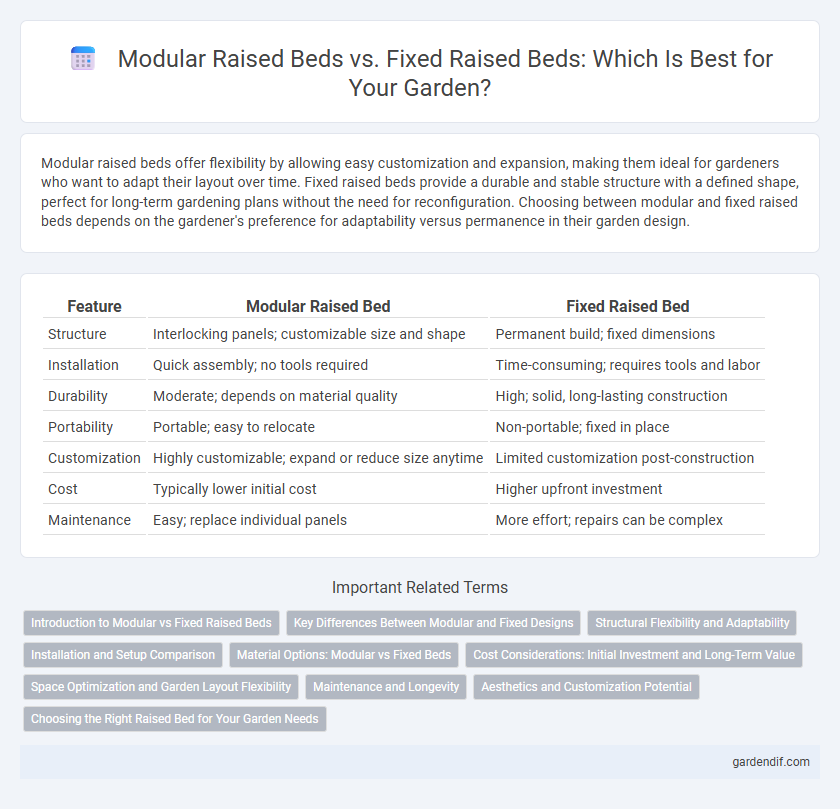
Modular Raised Bed vs Fixed Raised Bed Illustration
Modular raised beds offer flexibility by allowing easy customization and expansion, making them ideal for gardeners who want to adapt their layout over time. Fixed raised beds provide a durable and stable structure with a defined shape, perfect for long-term gardening plans without the need for reconfiguration. Choosing between modular and fixed raised beds depends on the gardener's preference for adaptability versus permanence in their garden design.
Table of Comparison
| Feature | Modular Raised Bed | Fixed Raised Bed |
|---|---|---|
| Structure | Interlocking panels; customizable size and shape | Permanent build; fixed dimensions |
| Installation | Quick assembly; no tools required | Time-consuming; requires tools and labor |
| Durability | Moderate; depends on material quality | High; solid, long-lasting construction |
| Portability | Portable; easy to relocate | Non-portable; fixed in place |
| Customization | Highly customizable; expand or reduce size anytime | Limited customization post-construction |
| Cost | Typically lower initial cost | Higher upfront investment |
| Maintenance | Easy; replace individual panels | More effort; repairs can be complex |
Introduction to Modular vs Fixed Raised Beds
Modular raised beds consist of individual sections that can be rearranged or expanded, offering flexibility for gardening layouts and crop rotation. Fixed raised beds are permanent structures, typically built from wood or stone, providing stability and consistent soil conditions over time. Choosing between modular and fixed raised beds depends on garden size, design preferences, and long-term maintenance plans.
Key Differences Between Modular and Fixed Designs
Modular raised beds feature interchangeable components that allow for easy customization, expansion, or relocation, while fixed raised beds are permanent structures built from solid materials like wood or stone. Modular designs offer flexibility in size and shape adjustments, making them ideal for gardeners who frequently change planting layouts or move their gardens. Fixed raised beds provide durability and stability, supporting long-term use without the need for disassembly or reconfiguration.
Structural Flexibility and Adaptability
Modular raised beds offer superior structural flexibility and adaptability compared to fixed raised beds, allowing gardeners to easily expand, reconfigure, or relocate sections based on changing space or planting needs. Fixed raised beds, constructed as permanent installations, provide stability but lack the versatility to adjust size or shape without extensive modification. The modular design enhances customization and efficient use of garden space, supporting diverse planting strategies throughout the growing season.
Installation and Setup Comparison
Modular raised beds offer flexible installation with interlocking panels that simplify assembly and allow for easy reconfiguration or expansion, while fixed raised beds require permanent construction often involving digging, cutting, and securing materials in place. Modular systems typically reduce setup time to under an hour without specialized tools, whereas fixed raised beds demand more labor and time due to their rigid design and foundation requirements. Choosing modular raised beds enhances adaptability and minimizes installation challenges, benefiting gardeners who need customizable garden layouts.
Material Options: Modular vs Fixed Beds
Modular raised beds offer versatile material options such as lightweight plastic, galvanized steel, and composite wood, allowing easy assembly and customization to fit various garden sizes. Fixed raised beds commonly use durable materials like cedar, redwood, or concrete blocks, providing long-lasting structural stability but limited flexibility in design. Choosing between modular and fixed raised beds depends on the gardener's preference for adaptability, material durability, and ease of installation.
Cost Considerations: Initial Investment and Long-Term Value
Modular raised beds typically require a higher initial investment due to interchangeable components and flexible design, but offer long-term value through easy expansion and reconfiguration without full replacement. Fixed raised beds usually have lower upfront costs with durable, single-structure builds but may incur additional expenses for repairs or complete rebuilding if modifications are needed. Evaluating cost considerations involves balancing the modular system's adaptability and potential savings against the fixed bed's stability and lower starting price.
Space Optimization and Garden Layout Flexibility
Modular raised beds offer superior space optimization by allowing gardeners to customize and expand their garden layout according to available space and planting needs. Unlike fixed raised beds, modular systems enable easy reconfiguration and adaptation, maximizing usable growing area in irregular or limited garden spaces. This flexibility supports efficient crop rotation and diversification, enhancing overall garden productivity.
Maintenance and Longevity
Modular raised beds offer easier maintenance due to their detachable components, allowing for simple repairs and replacements that extend overall longevity. Fixed raised beds, often constructed with durable materials like cedar or composite wood, typically require less frequent upkeep but can be harder to modify or repair once installed. The choice between modular and fixed raised beds significantly impacts long-term garden management and durability.
Aesthetics and Customization Potential
Modular raised beds offer superior aesthetics with sleek, modern designs and flexible configurations that adapt to any garden layout, enhancing visual appeal through customizable shapes and sizes. Fixed raised beds provide a more traditional look, often constructed from wood or stone, but lack versatility, limiting personalization options to initial dimensions and materials. Gardeners seeking to tailor their garden space dynamically will find modular systems more advantageous for creating visually cohesive and adaptable growing environments.
Choosing the Right Raised Bed for Your Garden Needs
Modular raised beds offer flexibility with customizable sizes and easy reconfiguration, making them ideal for gardeners who want to adapt their garden layout over time. Fixed raised beds provide durability and a stable structure, perfect for gardeners seeking a long-term, permanent planting solution. Evaluating garden space, budget, and desired maintenance level helps determine whether a modular or fixed raised bed best supports your planting goals and soil management.
Modular Raised Bed vs Fixed Raised Bed Infographic

 gardendif.com
gardendif.com